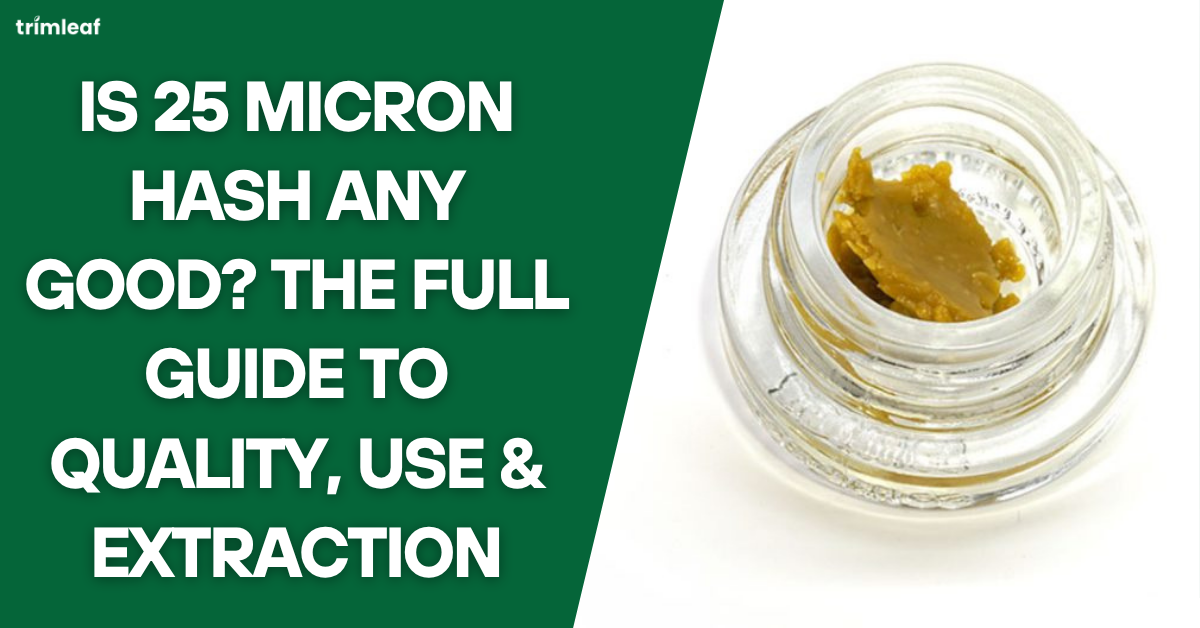
Micron size can make or break the final product. But one question continues to divide extractors and cannabis connoisseurs: is 25 micron hash good? Often overlooked or discarded making hash, this tiny mesh size is known for catching broken trichome heads and microscopic debris, it can also hold unexpected potential when handled with the right techniques and strains.
In this guide, we’ll break down what 25 micron hash really is, how it compares to other grades, and how to tell if it's worth keeping, pressing, or tossing.
If you want to get the most out of every wash, down to the very last micron, you’re in the right place.
Table of Contents
- What is a 25 Micron Hash?
- How Does 25 Micron Compare to Other Sizes?
- When Is 25 Micron Hash Good?
- When Is 25 Micron Hash NOT Good?
- Making the Most of 25 Micron Hash
- How to Evaluate 25 Micron Hash Quality
- Should You Keep or Toss 25 Micron Hash?
- Final Verdict: Is 25 Micron Hash Good?
- Frequently Asked Questions About 25 Micron Hash
What is a 25 Micron Hash?
25 micron hash is the material collected using a 25-micron mesh bag during the ice water extraction process. This bag features the finest screen typically included in a standard bubble bag set and is designed to capture the smallest particles. These often include broken trichome heads, stalk fragments, and microscopic plant debris.
In contrast to larger micron sizes, such as 73 or 90 microns, which are known for collecting fully intact trichome heads rich in cannabinoids and terpenes, the 25 micron bag gathers what slips through all the upper screens. While this fine-grade hash is sometimes overlooked or discarded, it can still contain useful resin depending on the strain and extraction method.
How Does 25 Micron Compare to Other Sizes?
Here's how 25 micron hash stacks up:
|
Micron Size |
What It Captures |
Typical Quality |
|
220µm, 190µm |
Large plant matter |
Discarded |
|
160µm, 120µm |
Trichome heads |
Mid-quality |
|
90µm, 73µm |
Mature heads |
Full melt (premium) |
|
45µm |
Small heads & stalks |
Usable |
|
25µm |
Fragments, dust |
Varies greatly |
When Is 25 Micron Hash Good?
1. Strain Dependent
Some strains, particularly indica-leaning cultivars with smaller gland heads, tend to yield more usable material in the 25µm range. Growers have reported success with strains like Purple Kush and Northern Lights, though not yet backed by controlled studies.
2. Cold and Gentle Extraction
When done with extreme care, low agitation and colder water can reduce contamination in the 25 micron range. This results in cleaner hash with better melt potential.
3. Pressing into Rosin
25µm hash often lacks the full-melt appeal for dabbing, but it can be pressed into rosin for a smooth, solventless extract. In fact, some rosin makers use 25µm hash exclusively for edibles and vapes.
When Is 25 Micron Hash NOT Good?
1. High Plant Contamination
Because the 25µm mesh catches ultra-fine particles, it's more prone to collecting contaminants like chlorophyll, dust, or even insect matter. To avoid this, use fresh frozen input, reduce wash time, and pre-rinse buds with cold water to wash off loose debris before running the bags.
2. Low Melt Quality
Most of the time, the resin from the 25 micron bag is non-full melt. It may bubble or blacken when dabbed, lacking the clear melt and flavor of top-shelf hash.
3. Difficult to Work With
25 micron bags tend to drain slowly and clog easily, increasing processing time for potentially low returns.
Making the Most of 25 Micron Hash

While 25 micron hash often gets overlooked, it can still be used with the right processing techniques and goals. Here’s how to maximize its potential:
✅Use Fresh Frozen Material
Always start with fresh, frozen flowers or trim. Flash-freezing your material preserves trichomes and reduces plant degradation, leading to cleaner, more resin-rich hash even in the finest micron sizes, like 25µm.
✅Blend with Higher Grades for Rosin
Pressing hash into rosin? Mix 25 micron hash with premium grades like 73µm or 90µm to create a more balanced, flavorful, and yield-efficient extract. This helps offset the lower melt quality of 25µm while still extracting valuable cannabinoids.
✅Test Before You Toss
Before discarding, do a simple melt test. If it bubbles and leaves minimal white ash, it may qualify as dab-worthy half or full melt. If it chars or stays solid, consider redirecting it toward non-inhaled products.
✅Use in Edibles, Capsules, or Topicals
Even if it's not ideal for dabbing, 25 micron hash still contains usable cannabinoids. It’s perfect for infusing into edibles, capsules, or topicals, where melt quality isn’t essential but potency and spectrum still matter.
💡 Pro Tip: Always decarb hash before cooking with it to activate THC and other cannabinoids.
How to Evaluate 25 Micron Hash Quality
Determining whether your 25 micron hash is worth keeping starts with a few key sensory checks. Because this grade often includes smaller resin glands and residual plant matter, quality can vary widely.
Performing the Melt Test
The melt test reveals how clean and potent your hash is when vaporized:

Full Melt
Full melt hash bubbles cleanly, leaves little to no residue, and melts into a clear or golden puddle, ideal for dabbing.
Half Melt
Bubbles but leaves behind dark or charred residue. Not ideal for dabbing, but may still be useful for pressing into rosin or infusing into edibles.
Non-Melt
Sizzles, blackens, and produces harsh smoke. Indicates heavy plant contamination or degraded resin. Best avoided for inhalation.
💡 Tip: Use a quartz banger or hot titanium dab tool at medium heat to get accurate results.
Visual & Physical Cues to Check
Beyond the melt test, evaluate your hash by appearance, smell, and texture:

Color
-
High-quality: Light blonde, golden, or sandy in color
-
Lower-quality: Dark brown, green, or grayish tones often signal plant material or oxidation
Texture
-
Desirable: Greasy, oily, sandy, or slightly sticky
-
Undesirable: Chalky, overly dry, or crumbly — these usually indicate degradation or contamination
Aroma
A strong, pleasant terpene profile (e.g., citrus, pine, gas) is a sign of good resin. A musty, hay-like, or grassy smell can signal poor processing or old material
25 micron hash can range from surprisingly excellent to barely usable, so always test small batches. If it melts clean and smells good, it may rival higher micron grades when used for rosin or infused products. If not, repurpose it smartly or let it go.
Should You Keep or Toss 25 Micron Hash?
KEEP IT if:
-
You're pressing rosin
-
The starting strain has tiny trichome heads
-
You want to use it in edibles, topicals, or capsules
TOSS IT if:
-
It’s contaminated, harsh, or tastes like hay
-
You're only after top-shelf melt
-
The labor outweighs the benefit in your setup
Final Verdict: Is 25 Micron Hash Good?
It depends. 25 micron hash is often a mixed bag, literally. While many hash makers discard it due to lower melt and high contamination risk, it can still offer value depending on strain genetics and processing technique. For extractors working with the right material and goals (like rosin pressing or edibles), it’s worth collecting and testing.
But if you're only after dab-ready, full melt hash, your best bet is the 73–90 micron range. Use 25 micron hash wisely — and don’t be afraid to experiment.
Frequently Asked Questions About 25 Micron Hash
- ◄What is 25-micron hash?
- 25-micron hash is the material collected using a 25µm mesh bag during ice water extraction. It captures the smallest particles, including broken trichome heads, stalks, and fine plant debris.
- ◄How does 25-micron hash compare to other micron sizes?
- While 73–90µm captures mature, full-melt trichome heads, 25µm collects what slips through — mostly fragments and micro-particles. It’s less consistent in quality but can still be useful.
- ◄Is 25-micron hash good for dabbing?
- Generally, no. Most 25-micron hash is not full melt and tends to char rather than vaporize cleanly. However, some strains and clean extractions may yield dab-worthy results.
- ◄When is 25-micron hash worth collecting?
- It’s worth keeping when working with strains that produce small trichome heads, when pressing rosin, or when making edibles or topicals. Always test before tossing.
- ◄Can 25-micron hash be pressed into rosin?
- Yes. While it may not be ideal for dabbing as-is, 25µm hash can be pressed into rosin for vapes or edibles. Blending it with higher grades improves flavor and yield.
- ◄How do I evaluate 25-micron hash quality?
- Use a melt test and check for light color, oily texture, and rich aroma. A full melt will bubble cleanly and leave little residue. If it chars or smells musty, skip it.
- ◄Is 25-micron hash more likely to be contaminated?
- Yes. The fine mesh can trap micro-contaminants like chlorophyll or dust. Using fresh frozen input and gentle washing helps reduce contamination.
- ◄What’s the best way to use 25-micron hash?
- It’s best suited for infusions—like edibles, capsules, or topicals—where melt quality is less critical, but potency and cannabinoid content still matter.
- ◄What are the risks of using 25-micron hash?
- Risks include contamination, poor melt quality, and inefficient processing time. It can clog bags and yield low returns if not handled properly.
- ◄Should I always collect 25-micron hash?
- No. If you're targeting premium full-melt hash, it's often not worth the effort. But if you want to maximize resin collection or make edibles, it can be very useful.




